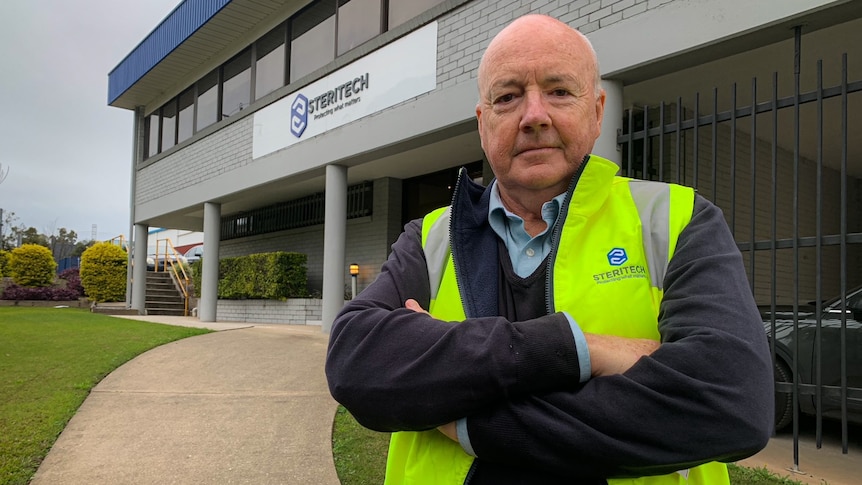John Irwin is the general manager of Steritech and on the frontline of Australia’s ongoing gas crisis.
Key points:
- State and federal energy ministers meet on Friday for the first time since the ACCC’s scathing report on the east coast gas market
- Industry has called for the government to “stand on the throat of gas producers” to ensure supply and fair prices
- The Australian Petroleum Production & Exploration Association says there is no gas cartel controlling prices on the east coast
“Without natural gas, we don’t operate our operations,” he said.
Steritech was one of the hundreds of manufacturers left exposed to the spot market when energy retailer Weston Energy collapsed in July.
Only two other gas providers were willing to consider signing a new supply deal with Steritech.
“And both of them were very unwilling to negotiate what we would consider a fair and long term price,” Mr Irwin said.
“It’s take it or leave it, you really don’t have a choice.”
Steritech is now paying up to four times what it used to for gas.
Mr Irwin said the dramatic price hike will eventually be passed through to patients on surgery operating tables around the country.
His company sterilises medical devices in procedure packs that are used in approximately 90 per cent of major operations in Australia.
“So increasing the price of those means that your health insurance is going to go up, and governments’ are going to have to spend more money in the public system for the materials being used,” Mr Irwin said.
Plenty of gas
Australia has plenty of gas and for decades the nation enjoyed cheap prices of around $5-a-gigajoule.
Technology enabled gas to be liquefied and sent overseas and Australia’s price became linked to the global market where prices are higher.
Recently prices on the east coast have skyrocketed as producers ramp up exports to supply a desperate global market caught short because of the war in Ukraine.
Mr Irwin does not hold back when it comes to who is responsible for the gas crisis.
“Both sides of politics have been in a situation where I don’t think they’ve represented the country too well,” he said.
“You’ve got to go back and look at who came up with a deal that does not ensure that we had appropriate domestic gas.
“The Australian community owns the gas in the ground, we license it out to gas companies to be able to extract it and deliver it to us, and you would expect that’s going to be done at a fair price.”
Malcolm Turnbull was prime minister in 2017 when he sat down with the heads of Santos, Shell and Origin and got them to agree to supply enough gas to the domestic market to fill projected shortfalls.
But he did not impose export or price controls, much like the current federal government in this current gas crisis.
Australians have been left paying more for our gas than overseas customers for long periods.
Last week the ACCC delivered a scathing report on the east coast gas market which detailed concerns about price-fixing behavior by exporters.
It also found profits had exploded compared to the cost of extracting gas.
It made similar findings in 2015, concluding that gas suppliers on the east coast had used a market restructure to hike prices on domestic consumers and evidence of collusion.
In its most recent report, the consumer watchdog concluded the east coast market is highly concentrated and dominated by the three LNG exporters, APLNG, GLNG and QCLNG, and their associates – controlling 90 per cent of the proven and probable gas reserves.
The damning ACCC report found exporters were withdrawing more from the domestic market than they were supplying, risking a 56 petajoule shortfall in 2023.
“On top of that it showed that they [exporters] pretty much ignored the heads of agreement that they had agreed with the Australian government [in 2017],” Mark Ogge, principal adviser on climate and energy at the Australian Institute, said.
“They weren’t providing gas at reasonable prices and reasonable terms and conditions to Australian gas customers – they were sending it overseas instead.
“The ACCC report doesn’t use the word cartel, but it describes cartel behaviour.
“If there’s cartel behaviour, if they have been colluding to keep prices high, then they’ve broken the law and that should be investigated.”
The Australian Energy Market Regulator has said it plans to investigate potentially illegal behavior by the gas companies.
The ACCC said it will review the arrangements of exporters and “where appropriate consider enforcement action”.
Bruce Robertson, an energy analyst with the Institute for Energy Economics and Financial Analysis (IEEFA) said Australia was in “a rolling energy crisis caused by the gas cartel”.
“They control and fix the price through their contracting mechanisms. All these are detailed in the ACCC report, and if it walks like a duck, quacks like a duck, waddles like a duck, it is a duck.
“What the gas cartel is doing is starving the Australian market of gas to force up the price. That’s what cartels do. They fix prices.
“This is a price fixing cartel. It’s illegal and it should be dealt with with the full force of the Australian law.”
Since the ACCC report was released on August 1, the gas price has been noticeably lower dropping to as low as $10.50-a-gigajoule.
“The gas price was as high as $55-a-gigajoule just two weeks ago in Sydney. So what we’ve seen is a collapse in the gas price. That could not have occurred without the gas cartel fixing the price,” Mr Robertson said.
“They’ve simply flooded the market in the short term, responding to political pressure that has come on with the ridiculous prices that they were charging Australian consumers.”
The peak body for gas producers the Australian Petroleum Production & Exploration Association (APPEA), said prices had dropped because of planned maintenance on LNG export facilities.
“That’s meant more gas has been able to flow into the market because those facilities are down for scheduled maintenance,” Damian Dwyer, APPEA acting chief executive said.
“And that’s a regular thing that happens this time of year and we’ve also seen warmer weather conditions that have meant less draw on gas for heating and power generation purposes than we saw in May.”
Mr Dwyer said there had been no collusion between gas companies.
“There’s been no behavior of that kind going on, what we’ve got is a market that has been under significant pressure,” he said.
“And that’s the energy market more broadly, not the gas market, the invasion of Ukraine and the international geopolitical tensions and disruptions to the energy market that have arisen from that.”
Electricity prices are going up
Gas is known as a price-setter in the National Electricity Market because gas-fired power plants step in to “smooth” the demand for energy when aging coal power stations are down or renewables aren’t working.
“A fair proportion of the electricity we use is generated by gas power stations at the moment,” Mr Ogge said.
“And with the price of gas going up to $40-a-gigajoule it meant that some gas power stations couldn’t produce gas for under $500-a-megawatt-hour.
“Previously the wholesale price of electricity was around $80 MWh, and these enormously high prices will flow onto Australian households and businesses.”
What’s the solution?
Unlike in Western Australia, which requires companies to reserve 15 per cent of gas for domestic use, there are no export limits or price caps on east coast gas.
Innes Willox from AiGroup said the longer the gas crisis drags on the more justification there was for an east coast reservation policy.
“It really is going to need government intervention, both at a federal and state level,” he said.
“And it’s going to need governments, quite frankly, to put their foot on the throat of gas producers to make sure they uphold their end of the bargain.
Mr Willox spent much of last year acting on behalf of industry trying to set up a code of conduct between gas producers and consumers – in the end, it fell over.
“Gas producers refused to touch issues around price, they wouldn’t go near it with a barge pole,” he said.
“They wouldn’t have price, content transparency as any part of a code of conduct, which rendered any sort of idea of a code of conduct completely useless, quite frankly.”
AiGroup does not support a “full blown reservation policy” but one that would only apply to new gas fields and take into consideration a “national interest test” on whether Australia had enough domestic supply.
Mr Robertson disagrees and argues that there should be no hesitation to apply a retrospective gas reservation policy with price controls, because gas companies have broken their original approval conditions by affecting the domestic market with exports.
“These players are now buying gas out of the domestic market, this is in direct contravention of their approval conditions,” Mr Robertson said.
“But law breaking just seems to go on and on in the gas industry in Australia and the government seems impotent.”
Windfall profits tax
Mr Ogge argues for a windfall profits tax, as the UK government has recently adopted in the face of soaring energy prices.
“A windfall profits tax is the only thing that we know will be effective,” he said.
“That’s because it would be very effective in reducing gas prices, because it removes the incentive for the LNG producers to export all their excess gas overseas to cash in on high gas prices.
“And it removes the incentive for them to charge Australian customers exorbitant prices for the gas that we use.
“On top of that, it provides funds for us to compensate Australian customers and businesses and households, and, money to actually help us electrify and get off gas so that we’re not permanently over the barrel of high international prices.”
tax time
According to analysis from the Australia Institute, five of the nation’s biggest gas producers haven’t paid income tax in at least seven years – despite combined earnings of $138 billion.
“It’s extraordinary when you think about it, that almost half the gas produced in Australia isn’t subject to any royalties at all – so they’re getting the gas for free,” Mr Ogge said.
“We’re getting a woefully inadequate return for Australians, and we’re paying huge additional energy costs.
“It’s high time the Australian government got onto this issue and fixed it.”
Mr Dwyer said the industry is paying its fair share of tax.
“The industry pays taxes or royalties to every jurisdiction. And the way in which that plays out just depends on the jurisdiction in question.”
The industry rejects the need for a reservation policy or price controls, arguing there is not a supply problem — at the same it wants to extract gas from new fields.
“We need is ongoing investment to bring more gas supply into the market, so we’re keen to talk with the government about their way forward,” Mr Dwyer said.
.

